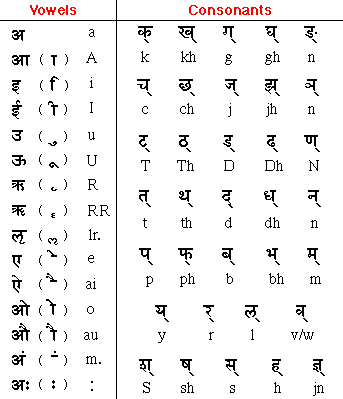TRANSLITERATION KEY

It is impossible not to use Sanskrit (sam.skRta) words when talking of
advaita vedAnta. I have kept philosophical terms, which often have meanings
specific to the school of advaita, in the original sam.skRta, instead of
translating them into English.
Here is the key to the transliteration rules that I follow when I use a
sam.skRta word in the middle of English text. This transliteration is by
no means perfect, but it is meant for easy online representation in the
international Roman alphabet. The intention is to convey a flavor of the
original pronunciation of the sam.skRta words. I have avoided the use of
additional diacritical marks as much as possible, by making use of upper-case
letters. Basic knowledge of the devanAgari script is assumed.

NOTES:
- The pronunciation of vowels is closer to German usage than to English.
Note the dots "." used in the vowel list (e.g. m. and lr.). "R" is used in words such
as Rshi, bRhad etc. RR and lr. are included for the sake of completeness.
- The avagraha sign (indicating an elided "a") is depicted as ' - an
apostrophe. This sign is not included in the above image.
 are all transliterated as "n".
The pronunciation is clear from the context, as they occur mostly in conjunct
formations.
are all transliterated as "n".
The pronunciation is clear from the context, as they occur mostly in conjunct
formations.
- visarga ( : ) is used only in quotations.
- Aspirated and non-aspirated consonants are indicated by separate signs
in Indian scripts. Thus, "p" is always non-aspirated, while "ph" is always an
aspirated sound.
- Upper-case letters are used in both the vowel and consonant lists for
transliteration. Generally, an upper-case vowel , e.g. "A", is a longer version of
the corresponding lower-case vowel, here "a". Upper-case consonants are used
only in one series (T ... N). Upper-case letters are avoided in all the other
series, in order to be unambiguous and to maintain uniformity.
- Consequently, sentences that incorporate sam.skr.ta words appear to
deviate from normal English punctuation. The only exceptions to this occur
in the titles, which are all in capitals. Here, a larger font size is used to denote
a sound that would normally require an upper-case letter.
- The transliteration scheme is used only for words that are specifically
related to advaita vedAnta. Thus, names of Indian states or cities are spelt
according to usual convention.
- The spelling Sankara is used, instead of Sam.kara.
Acknowledgement: Prof. Ashok Aklujkar of
the University of British Columbia provided the devanAgari font used in the
above scheme, and in the gif files at the Slokas page.

Last updated on May 5, 1999.
![]()
![]()

 are all transliterated as "n".
The pronunciation is clear from the context, as they occur mostly in conjunct
formations.
are all transliterated as "n".
The pronunciation is clear from the context, as they occur mostly in conjunct
formations.